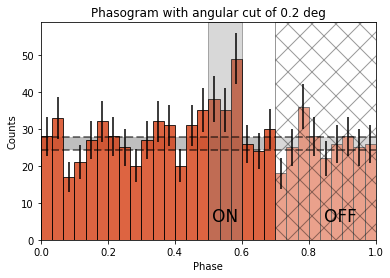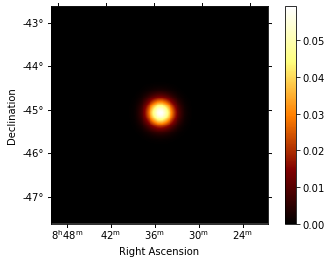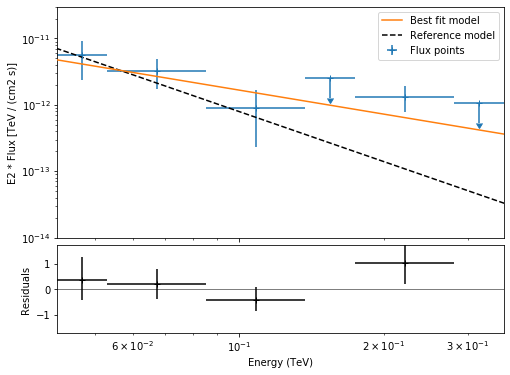This is a fixed-text formatted version of a Jupyter notebook
You can contribute with your own notebooks in this GitHub repository.
Source files: pulsar_analysis.ipynb | pulsar_analysis.py
Pulsar analysis with Gammapy¶
Introduction¶
This notebook shows how to do a pulsar analysis with Gammapy. It’s based on a Vela simulation file from the CTA DC1, which already contains a column of phases. We will produce a phasogram, a phase-resolved map and a phase-resolved spectrum of the Vela pulsar using the class PhaseBackgroundEstimator.
The phasing in itself is not done here, and it requires specific packages like Tempo2 or PINT.
Opening the data¶
Let’s first do the imports and load the only observation containing Vela in the CTA 1DC dataset shipped with Gammapy.
[1]:
%matplotlib inline
import numpy as np
import matplotlib.pyplot as plt
[2]:
from gammapy.utils.regions import SphericalCircleSkyRegion
from astropy.coordinates import SkyCoord
import astropy.units as u
from gammapy.cube import SafeMaskMaker
from gammapy.maps import Map, WcsGeom
from gammapy.data import DataStore
from gammapy.modeling.models import PowerLawSpectralModel, SkyModel
from gammapy.modeling import Fit, Datasets
from gammapy.spectrum import (
PhaseBackgroundMaker,
SpectrumDataset,
SpectrumDatasetMaker,
FluxPointsEstimator,
FluxPointsDataset,
)
Load the data store (which is a subset of CTA-DC1 data):
[3]:
data_store = DataStore.from_dir("$GAMMAPY_DATA/cta-1dc/index/gps")
Define obsevation ID and print events:
[4]:
id_obs_vela = [111630]
obs_list_vela = data_store.get_observations(id_obs_vela)
print(obs_list_vela[0].events)
EventList info:
- Number of events: 101430
- Median energy: 0.1 TeV
- OBS_ID = 111630
Now that we have our observation, let’s select the events in 0.2° radius around the pulsar position.
[5]:
pos_target = SkyCoord(ra=128.836 * u.deg, dec=-45.176 * u.deg, frame="icrs")
on_radius = 0.2 * u.deg
on_region = SphericalCircleSkyRegion(pos_target, on_radius)
# Apply angular selection
events_vela = obs_list_vela[0].events.select_region(on_region)
print(events_vela)
EventList info:
- Number of events: 843
- Median energy: 0.107 TeV
- OBS_ID = 111630
Let’s load the phases of the selected events in a dedicated array.
[6]:
phases = events_vela.table["PHASE"]
# Let's take a look at the first 10 phases
phases[:10]
[6]:
| 0.81847286 |
| 0.45646095 |
| 0.111507416 |
| 0.43416595 |
| 0.76837444 |
| 0.3639946 |
| 0.58693695 |
| 0.51095676 |
| 0.5606985 |
| 0.2505703 |
Phasogram¶
Once we have the phases, we can make a phasogram. A phasogram is a histogram of phases and it works exactly like any other histogram (you can set the binning, evaluate the errors based on the counts in each bin, etc).
[7]:
nbins = 30
phase_min, phase_max = (0, 1)
values, bin_edges = np.histogram(
phases, range=(phase_min, phase_max), bins=nbins
)
bin_width = (phase_max - phase_min) / nbins
bin_center = (bin_edges[:-1] + bin_edges[1:]) / 2
# Poissonian uncertainty on each bin
values_err = np.sqrt(values)
[8]:
plt.bar(
x=bin_center,
height=values,
width=bin_width,
color="#d53d12",
alpha=0.8,
edgecolor="black",
yerr=values_err,
)
plt.xlim(0, 1)
plt.xlabel("Phase")
plt.ylabel("Counts")
plt.title(f"Phasogram with angular cut of {on_radius}");

Now let’s add some fancy additions to our phasogram: a patch on the ON- and OFF-phase regions and one for the background level.
[9]:
# Evaluate background level
off_phase_range = (0.7, 1.0)
on_phase_range = (0.5, 0.6)
mask_off = (off_phase_range[0] < phases) & (phases < off_phase_range[1])
count_bkg = mask_off.sum()
print(f"Number of Off events: {count_bkg}")
Number of Off events: 234
[10]:
# bkg level normalized by the size of the OFF zone (0.3)
bkg = count_bkg / nbins / (off_phase_range[1] - off_phase_range[0])
# error on the background estimation
bkg_err = (
np.sqrt(count_bkg) / nbins / (off_phase_range[1] - off_phase_range[0])
)
[11]:
# Let's redo the same plot for the basis
plt.bar(
x=bin_center,
height=values,
width=bin_width,
color="#d53d12",
alpha=0.8,
edgecolor="black",
yerr=values_err,
)
# Plot background level
x_bkg = np.linspace(0, 1, 50)
kwargs = {"color": "black", "alpha": 0.5, "ls": "--", "lw": 2}
plt.plot(x_bkg, (bkg - bkg_err) * np.ones_like(x_bkg), **kwargs)
plt.plot(x_bkg, (bkg + bkg_err) * np.ones_like(x_bkg), **kwargs)
plt.fill_between(
x_bkg, bkg - bkg_err, bkg + bkg_err, facecolor="grey", alpha=0.5
) # grey area for the background level
# Let's make patches for the on and off phase zones
on_patch = plt.axvspan(
on_phase_range[0], on_phase_range[1], alpha=0.3, color="gray", ec="black"
)
off_patch = plt.axvspan(
off_phase_range[0],
off_phase_range[1],
alpha=0.4,
color="white",
hatch="x",
ec="black",
)
# Legends "ON" and "OFF"
plt.text(0.55, 5, "ON", color="black", fontsize=17, ha="center")
plt.text(0.895, 5, "OFF", color="black", fontsize=17, ha="center")
plt.xlabel("Phase")
plt.ylabel("Counts")
plt.xlim(0, 1)
plt.title(f"Phasogram with angular cut of {on_radius}");

Phase-resolved map¶
Now that the phases are computed, we want to do a phase-resolved sky map : a map of the ON-phase events minus alpha times the OFF-phase events. Alpha is the ratio between the size of the ON-phase zone (here 0.1) and the OFF-phase zone (0.3). It’s a map of the excess events in phase, which are the pulsed events.
[12]:
geom = WcsGeom.create(binsz=0.02 * u.deg, skydir=pos_target, width="5 deg")
Let’s create an ON-map and an OFF-map:
[13]:
on_map = Map.from_geom(geom)
off_map = Map.from_geom(geom)
events_vela_on = events_vela.select_parameter("PHASE", on_phase_range)
events_vela_off = events_vela.select_parameter("PHASE", off_phase_range)
[14]:
on_map.fill_events(events_vela_on)
off_map.fill_events(events_vela_off)
# Defining alpha as the ratio of the ON and OFF phase zones
alpha = (on_phase_range[1] - on_phase_range[0]) / (
off_phase_range[1] - off_phase_range[0]
)
# Create and fill excess map
# The pulsed events are the difference between the ON-phase count and alpha times the OFF-phase count
excess_map = on_map - off_map * alpha
# Plot excess map
excess_map.smooth(kernel="gauss", width=0.2 * u.deg).plot(add_cbar=True);

Phase-resolved spectrum¶
We can also do a phase-resolved spectrum. In order to do that, there is the class PhaseBackgroundMaker. In a phase-resolved analysis, the background is estimated in the same sky region but in the OFF-phase zone.
[15]:
e_true = np.logspace(-2.5, 1, 100) * u.TeV
e_reco = np.logspace(-2, 1, 30) * u.TeV
dataset_empty = SpectrumDataset.create(
e_reco=e_reco, e_true=e_true, region=on_region
)
dataset_maker = SpectrumDatasetMaker()
phase_bkg_maker = PhaseBackgroundMaker(
on_phase=on_phase_range, off_phase=off_phase_range
)
safe_mask_maker = SafeMaskMaker(
methods=["aeff-default", "edisp-bias"], bias_percent=20
)
datasets = []
for obs in obs_list_vela:
dataset = dataset_maker.run(dataset_empty, obs)
dataset_on_off = phase_bkg_maker.run(dataset, obs)
dataset_on_off = safe_mask_maker.run(dataset_on_off, obs)
datasets.append(dataset_on_off)
No thresholds defined for obs Info for OBS_ID = 111630
- Start time: 59300.83
- Pointing pos: RA 130.89 deg / Dec -44.63 deg
- Observation duration: 1800.0 s
- Dead-time fraction: 2.000 %
Now let’s a look at the datasets we just created:
[16]:
datasets[0].peek()

Now we’ll fit a model to the spectrum with the Fit class. First we load a power law model with an initial value for the index and the amplitude and then wo do a likelihood fit. The fit results are printed below.
[17]:
spectral_model = PowerLawSpectralModel(
index=4, amplitude="1.3e-9 cm-2 s-1 TeV-1", reference="0.02 TeV"
)
model = SkyModel(spectral_model=spectral_model)
emin_fit, emax_fit = (0.04 * u.TeV, 0.4 * u.TeV)
for dataset in datasets:
dataset.models = model
dataset.mask_fit = dataset.counts.energy_mask(emin=emin_fit, emax=emax_fit)
joint_fit = Fit(datasets)
joint_result = joint_fit.run()
model.spectral_model.parameters.covariance = joint_result.parameters.covariance
print(joint_result)
OptimizeResult
backend : minuit
method : minuit
success : True
message : Optimization terminated successfully.
nfev : 98
total stat : 5.69
Now you might want to do the stacking here even if in our case there is only one observation which makes it superfluous. We can compute flux points by fitting the norm of the global model in energy bands.
[18]:
e_edges = np.logspace(np.log10(0.04), np.log10(0.4), 7) * u.TeV
dataset = Datasets(datasets).stack_reduce()
dataset.model = model
fpe = FluxPointsEstimator(datasets=[dataset], e_edges=e_edges)
flux_points = fpe.run()
flux_points.table["is_ul"] = flux_points.table["ts"] < 1
amplitude_ref = 0.57 * 19.4e-14 * u.Unit("1 / (cm2 s MeV)")
spec_model_true = PowerLawSpectralModel(
index=4.5, amplitude=amplitude_ref, reference="20 GeV"
)
flux_points_dataset = FluxPointsDataset(data=flux_points, models=model)
Now we can plot.
[19]:
plt.figure(figsize=(8, 6))
ax_spectrum, ax_residual = flux_points_dataset.peek()
ax_spectrum.set_ylim([1e-14, 3e-11])
ax_residual.set_ylim([-1.7, 1.7])
spec_model_true.plot(
ax=ax_spectrum,
energy_range=(emin_fit, emax_fit),
label="Reference model",
c="black",
linestyle="dashed",
energy_power=2,
)
ax_spectrum.legend(loc="best")
[19]:
<matplotlib.legend.Legend at 0x11d792b70>

This tutorial suffers a bit from the lack of statistics: there were 9 Vela observations in the CTA DC1 while there is only one here. When done on the 9 observations, the spectral analysis is much better agreement between the input model and the gammapy fit.
[ ]: